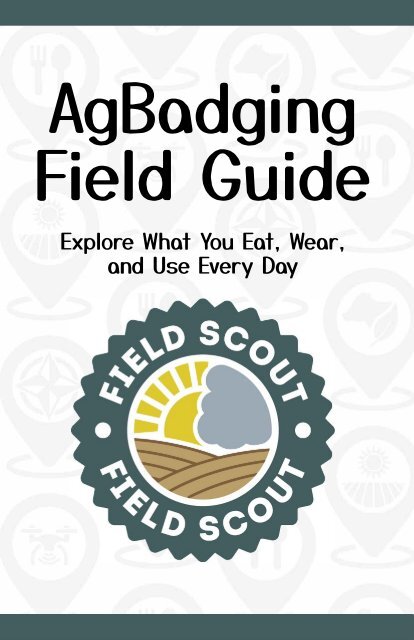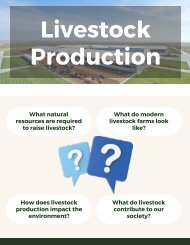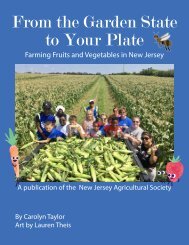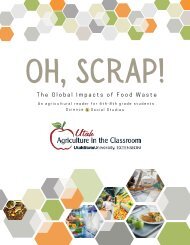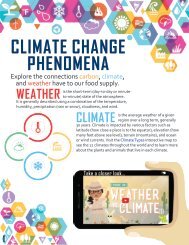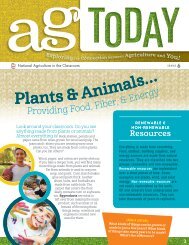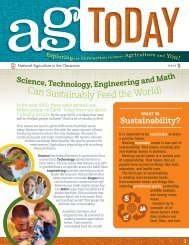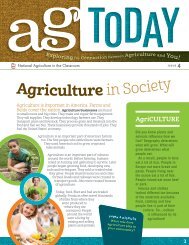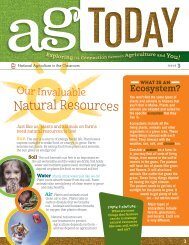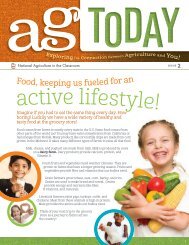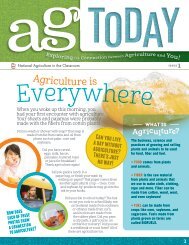AgBadging Field Guide
The AgBadging Field Guide will lead you through an exciting exploration of agriculture—what you eat, wear, and use every day. Throughout your journey, you will have the opportunity to earn five different badges—Agriculture & the Environment, Plants & Animals, Food & Health, Technology & Engineering, and Geography & Culture. The AgBadging Field Guide was developed for youth ages 8-11.
The AgBadging Field Guide will lead you through an exciting exploration of agriculture—what you eat, wear, and use every day. Throughout your journey, you will have the opportunity to earn five different badges—Agriculture & the Environment, Plants & Animals, Food & Health, Technology & Engineering, and Geography & Culture. The AgBadging Field Guide was developed for youth ages 8-11.
You also want an ePaper? Increase the reach of your titles
YUMPU automatically turns print PDFs into web optimized ePapers that Google loves.
<strong>AgBadging</strong><br />
<strong>Field</strong> <strong>Guide</strong><br />
Explore What You Eat, Wear,<br />
and Use Every Day
<strong>AgBadging</strong><br />
<strong>Field</strong> <strong>Guide</strong><br />
Explore What You Eat, Wear, and Use Every Day<br />
This <strong>Field</strong> <strong>Guide</strong> Belongs To:<br />
My Code Name:<br />
agbadging.agclassroom.org
This work is licensed under the Creative Commons Attribution-<br />
NonCommercial-NoDerivatives 4.0 International License. To view<br />
a copy of this license, visit creativecommons.org/licenses/bync-nd/4.0/<br />
or send a letter to Creative Commons, PO Box 1866,<br />
Mountain View, CA 94042, USA<br />
Published and Distributed by:<br />
National Center for Agricultural Literacy<br />
Utah State University<br />
2305 Old Main Hill<br />
Logan, UT 84322-2305<br />
(435) 797-0765<br />
agliteracy.org<br />
agclassroom.org<br />
Author: Lynn Wallin<br />
Editors: Debra Spielmaker, Andrea Gardner, and Denise Stewardson
TABLE OF CONTENTS<br />
Agriculture & the Environment Badge . . . . . . . . . . . . . . 1<br />
Plants & Animals Badge . . . . . . . . . . . . . . . . . . . . . . . . . . . . . 16<br />
Food & Health Badge . . . . . . . . . . . . . . . . . . . . . . . . . . . . . . . 27<br />
Technology & Engineering Badge . . . . . . . . . . . . . . . . . 34<br />
Geography & Culture Badge . . . . . . . . . . . . . . . . . . . . . . 43<br />
Glossary . . . . . . . . . . . . . . . . . . . . . . . . . . . . . . . . . . . . . . . . . . . 54<br />
Badges . . . . . . . . . . . . . . . . . . . . . . . . . . . . . . . . . . . . . . . . . . . 57<br />
Do you want to change the world? Work in<br />
agriculture. It will be an entomologist who<br />
cures malaria. It will be a hydrologist who<br />
creates clean water for the world. It will be a<br />
plant breeder that will solve world hunger.<br />
Keegan Kautzky, World Food Prize Foundation
Welcome to the <strong>AgBadging</strong> <strong>Field</strong> <strong>Guide</strong><br />
The <strong>AgBadging</strong> <strong>Field</strong> <strong>Guide</strong> will lead you through an exciting<br />
exploration of agriculture—what you eat, wear, and use every<br />
day. Throughout your journey, you will have the opportunity to<br />
earn five different badges. Each badge has a theme—Agriculture<br />
& the Environment, Plants & Animals, Food & Health,<br />
Technology & Engineering, and Geography & Culture.<br />
Each theme has milestones that track your agricultural journey.<br />
The best part is that you get to choose your own milestones!<br />
This field guide has spaces for writing and drawing your<br />
observations and ideas as you explore the milestones. This is a<br />
great way to record your discoveries and share your journey with<br />
family and friends.<br />
After you finish a milestone, record the completion date and<br />
get it signed off by an adult (a parent, grandparent, guardian,<br />
teacher, youth leader, etc.). The first page for each theme has a<br />
spot for you to write the date and the adult to sign their initials.<br />
When you complete three milestones in a theme, you earn a<br />
special badge to recognize your accomplishment! While three<br />
are required to earn your badge, feel free to explore more<br />
milestones. Badges can be found at the back of this field guide.<br />
Place your earned badge on the first page of the theme.<br />
After you collect badges for all five themes, you earn a<br />
completion badge and a <strong>Field</strong> Scout Code Name. Visit agbadging.<br />
agclassroom.org to receive your code name. Please note: You<br />
will not be asked to provide any personal information to receive<br />
your code name. Attach your badge to the title page of your field<br />
guide and write your code name below.<br />
You can find more information about the milestones in this field<br />
guide, including videos, games, and activity tutorials by visiting<br />
agbadging.agclassroom.org.
Agriculture & the<br />
Environment Badge<br />
Place<br />
Completion<br />
Badge Here<br />
Agriculture is the science, art, or practice of<br />
cultivating the soil, producing crops, and raising<br />
livestock, and, in varying degrees, the preparation and<br />
marketing of the resulting products. Ecosystems include the plants,<br />
animals, and other organisms living in an area. Agriculture works with<br />
natural ecosystems. These living things interact with each other and<br />
with elements of the environment (the sun, soil, weather, and climate).<br />
Major types of ecosystems include forest, grassland, desert, tundra,<br />
freshwater, and marine.<br />
Choose and complete at least three of the milestones below to earn<br />
the Agriculture & the Environment Badge.<br />
It is impossible to have a healthy and sound<br />
society without a proper respect for the soil.<br />
Peter Maurin, Philosopher and Social Critic<br />
Seed Sprout (page 2)<br />
Date Completed:<br />
Weather Watch (page 5)<br />
Date Completed:<br />
Soil Investigation (page 8)<br />
Date Completed:<br />
Compost Bottle (page 11)<br />
Date Completed:<br />
Light Investigation (page 14)<br />
Date Completed:<br />
Adult Initials:<br />
Adult Initials:<br />
Adult Initials:<br />
Adult Initials:<br />
Adult Initials:<br />
1
Seed Sprout<br />
The germination process can be somewhat mysterious because it<br />
typically occurs underground where it cannot be observed. In order for<br />
a seed to germinate (sprout), it needs warmth, moisture, and air. Seeds<br />
remain dormant and will not germinate until the proper conditions are<br />
present. Moisture softens the seed’s outer protective covering called<br />
the seed coat. The embryo pushes through the softened seed coat,<br />
and the new plant begins to grow. The roots push farther down and<br />
a shoot, which contains the plant’s new stems and leaves, pushes up<br />
towards the surface.<br />
Materials:<br />
Sandwich-sized resealable plastic bag<br />
3 cotton balls<br />
6 seeds (most bean seeds or popcorn kernels/seeds will work)<br />
Instructions:<br />
1. Read the paragraph above and circle what a seed needs to germinate.<br />
2. Gather the materials to germinate seeds in a plastic bag.<br />
3. Dip the cotton balls into water. Squeeze excess water out of the<br />
cotton balls so that they are wet but not dripping.<br />
4. Add two seeds to each cotton ball, one on each side.<br />
5. Place the seeded cotton balls into the plastic bag and seal the bag.<br />
6. Record daily observations<br />
for 10 days by drawing Example<br />
pictures with descriptions<br />
on pages 3 & 4.<br />
7. After observing the seeds<br />
and seedlings for 10 days,<br />
write at least one paragraph<br />
explaining why farmers<br />
need to understand the<br />
germination process.<br />
2<br />
Agriculture & the Environment Badge
Seed Sprout Observations<br />
Day 1 Day 2<br />
Day 3 Day 4<br />
Day 5 Day 6<br />
Agriculture & the Environment Badge<br />
3
Day 7 Day 8<br />
Day 9 Day 10<br />
4<br />
Agriculture & the Environment Badge
Weather Watch<br />
Weather describes the state of the atmosphere—the thick blanket<br />
of air surrounding the Earth—at a certain time and place. Weather<br />
is caused by heat, water, and air. Temperature, the amount and type<br />
of moisture in the air, and the strength of the wind are different<br />
components of weather. Severe weather events such as floods,<br />
extreme cold or heat, intense winds, hail, or tornadoes can negatively<br />
impact farms and ranches—the places where our food is grown or<br />
raised. Weather forecasters use science to predict what the weather<br />
will be on a particular day and can help farmers and ranchers make<br />
decisions on the farm. Severe weather warnings can help farmers and<br />
ranchers minimize damage to crops, animals, and property.<br />
Instructions:<br />
1. Observe the weather for one week. Make observations about what<br />
you see and feel, and watch your local weather reports on the news<br />
or a weather app. Record your observations on page 6.<br />
2. On page 7, record the date, time, wind speed, wind direction,<br />
atmospheric pressure, air temperature, humidity, and precipitation on<br />
a daily basis.<br />
3. After observing the weather for one week, make a video of yourself<br />
reporting the weather you documented. In your weather report,<br />
explain how the weather could affect farms and ranches.<br />
Agriculture & the Environment Badge<br />
5
Weather Observations<br />
6<br />
Agriculture & the Environment Badge
Date<br />
Time<br />
Wind<br />
Speed<br />
Weather Observations<br />
Wind<br />
Direction<br />
Atmospheric<br />
Pressure<br />
Air<br />
Temperature<br />
Humidity Precipitation<br />
Agriculture & the Environment Badge<br />
7
Soil Investigation<br />
Soil is the foundation for agriculture. We need healthy soil to grow the<br />
plants we use for food, fiber/fabric, and shelter. Soil is composed of<br />
four elements—air, water, organic matter (decomposed material from<br />
once-living organisms), and non-living mineral particles (tiny pieces<br />
of weathered rock). There are many different types of soil and each is<br />
made up of different components. Soil is composed of three different<br />
types of particles that are classified as sand, silt, or clay.<br />
Materials:<br />
3 planting pots Lettuce seeds<br />
Potting soil<br />
Local soil<br />
Sand<br />
Instructions:<br />
1. Investigate the importance of the type of soil for plant growth by<br />
planting seeds in different types of soil.<br />
2. Fill each of the three planting pots with a different type of soil—<br />
potting soil, local soil, and sand.<br />
3. Plant three seeds in each pot about 1/2-inch deep and cover with soil.<br />
4. Place the pots in a sunny place and water according to the<br />
instructions on the seed packet.<br />
5. Over a three-week period, record observations on page 9.<br />
6. After observing the plants for three weeks, write at least one<br />
paragraph on page 10<br />
explaining why farmers need<br />
to understand the types of<br />
soil they are working with<br />
on their farms.<br />
Example<br />
Week 1<br />
Example<br />
Week 2<br />
Example<br />
Week 3<br />
8<br />
Agriculture & the Environment Badge
Week 1<br />
Pot A<br />
Week 1<br />
Pot B<br />
Week 1<br />
Pot C<br />
Week 2<br />
Pot A<br />
Week 2<br />
Pot B<br />
Week 2<br />
Pot C<br />
Week 3<br />
Pot A<br />
Week 3<br />
Pot B<br />
Week 3<br />
Pot C<br />
Agriculture & the Environment Badge<br />
9
Plant Observations<br />
10<br />
Agriculture & the Environment Badge
Compost Bottle<br />
Decomposition is a fundamental process on which all life depends.<br />
Bacteria, fungi, and other microscopic organisms that live in the<br />
soil, air, and water are responsible for turning once-living plants and<br />
animals into nutrients. Composting takes advantage of microbial<br />
decomposition to turn farm, garden, and kitchen wastes into a<br />
nutrient-rich soil amendment (a material added to soil to improve it).<br />
Adding compost to the soil provides nutrients to plants, improves soil<br />
structure, and increases the water-holding capacity of the soil.<br />
Materials:<br />
2-liter bottle with lid (cleaned and dried)<br />
Soil<br />
Dried leaves or grass clippings, and food scraps (egg shells; banana,<br />
potato, or apple peels; fruit/vegetable scraps; CAUTION: no meat<br />
or dairy)<br />
Water spray bottle<br />
Scissors or utility knife<br />
Instructions:<br />
1. Have an adult help cut the top 4.5 inches off<br />
of the bottle with scissors or a utility knife.<br />
2. Add layers of soil, dried leaves or grass<br />
clippings, and food scraps to the bottle until<br />
it is half full. Spray each layer with water to<br />
moisten before adding the next.<br />
3. Put the top of the bottle upside down into<br />
the container.<br />
4. Place the compost bottle in a warm location.<br />
5. Keep the contents moistened and mix 1-2<br />
times a week.<br />
6. After observing and recording the changes<br />
to the materials in the bottle for four weeks<br />
on page 12, write at least one paragraph on<br />
page 13 explaining why farmers may add<br />
compost and other organic materials to their<br />
fields.<br />
Example<br />
11<br />
Agriculture & the Environment Badge
Week 1 Week 2<br />
Week 3 Week 4<br />
12<br />
Agriculture & the Environment Badge
Composting Observations<br />
Agriculture & the Environment Badge<br />
13
Light Investigation<br />
Green plants need light to perform photosynthesis. Photosynthesis is<br />
the process by which green plants transform light energy into chemical<br />
energy. Plants use the energy of light to convert carbon dioxide and<br />
water into sugar (glucose) and oxygen. Plants make their own food<br />
using photosynthesis. Plant leaves are the main site for photosynthesis<br />
to take place.<br />
Materials:<br />
House plant<br />
Aluminum foil<br />
Paper clips<br />
Instructions:<br />
1. Investigate the importance of light to plants by comparing leaves<br />
that are exposed to light and leaves that are not.<br />
2. Observe your plant on Day 1 and draw a picture of it on page 15.<br />
3. Cut aluminum foil into small pieces that will cover the plant’s leaves.<br />
4. Use paper clips to secure the foil pieces to several leaves. Allow<br />
some leaves to stay uncovered.<br />
5. Place the plant in a location with indirect light for five days.<br />
6. After five days, remove the paper<br />
clips and foil.<br />
7. On Day 5, draw a picture of your<br />
plant on page 15. Observe the<br />
differences between the leaves<br />
exposed to the light and the<br />
leaves that were covered.<br />
8. Write at least one paragraph<br />
explaining why it is important<br />
for farmers to understand the<br />
Example<br />
process of photosynthesis.<br />
14<br />
Agriculture & the Environment Badge
Day 1 Day 5<br />
Leaf Observations<br />
Agriculture & the Environment Badge<br />
15
Plants &<br />
Animals Badge<br />
Place<br />
Completion<br />
Badge Here<br />
Early humans developed agriculture as an<br />
alternative to hunting and gathering. Since the<br />
domestication of plants and animals, humans have<br />
been experimenting with genetics, types of soil, climate, production<br />
practices, and harvesting to meet the needs of a growing population.<br />
Agriculture provides the food supply needed for the survival, growth,<br />
and health of humans and animals.<br />
Choose and complete at least three of the milestones below to earn<br />
the Plants & Animals Badge.<br />
Do what you love to do, and be around things that<br />
make you happy. The cows make me smile every day.<br />
David Jackson, Bentwood Dairy, Texas<br />
Agriculture and Me (page 17)<br />
Date Completed:<br />
Farm Tour (page 19)<br />
Date Completed:<br />
Life Cycles (page 20)<br />
Date Completed:<br />
Eating Plants (page 23)<br />
Date Completed:<br />
Pollinator Hotel (page 25)<br />
Date Completed:<br />
Adult Initials:<br />
Adult Initials:<br />
Adult Initials:<br />
Adult Initials:<br />
Adult Initials:<br />
16
Agriculture and Me<br />
Many of the products we use every day come from agriculture—from<br />
the food we eat to the clothes we wear to the items we use daily.<br />
When you wake up in the morning, you might be lying on cotton<br />
sheets. Your pillow could be filled with down feathers from a goose.<br />
The frame of your bed is probably made of wood. These are all<br />
agricultural products, and you aren’t even out of bed yet!<br />
Instructions:<br />
1. Make a list of all the agricultural products you use in a day.<br />
2. Put a star by all the animal products.<br />
3. Put a check mark by all the plant products.<br />
4. Highlight all the products you eat in orange.<br />
5. Highlight all the products you wear in yellow.<br />
6. Highlight all the products that you use but do not eat or wear in blue.<br />
7. Write at least one paragraph explaining how agriculture affects your<br />
daily life.<br />
Agricultural Products<br />
Plants & Animals Badge<br />
17
18<br />
Plants & Animals Badge
Farm Tour<br />
There are many different kinds of farms. Farms may raise animals<br />
such as poultry, livestock, fish, or bees, or they may grow crops such<br />
as fruits, vegetables, and grains. Farms can be hobby-sized, familyowned,<br />
or large-scale. Farm size depends on the availability of land and<br />
resources such as money and workers to manage the farm.<br />
Instructions:<br />
1. Visit a farm either in person or virtually. For links to virtual farm<br />
tours, visit agclassroom.org/student/virtual.<br />
2. Record your observations about the farm.<br />
3. Film a commercial featuring the farm and the products it<br />
grows or raises.<br />
Farm Observations<br />
Plants & Animals Badge<br />
19
Life Cycles<br />
Farmers must understand the needs of the animals and plants they<br />
raise and grow at each stage of the animals’ and plants’ life cycle. All<br />
plants and animals have a beginning and ending to their life cycles.<br />
Baby animals grow into adult animals and can become parents. Animals<br />
are fed and cared for by farmers and ranchers according to the animals’<br />
needs and their stages of life. There are six stages in a plant life<br />
cycle—seed, germination, growth, reproduction, pollination, and seed<br />
spreading. A plant grown for food and fiber can be classified by how<br />
long it takes the plant to complete its life cycle. An annual plant has<br />
a life cycle of one year, the life cycle of a biennial is two years, and a<br />
perennial lives for many seasons.<br />
Instructions:<br />
1. Choose a crop or farm animal to research.<br />
2. Draw a diagram of the plant’s or animal’s life cycle.<br />
3. Explain the plant’s or animal’s life cycle to a family member or<br />
friend. Include reasons why it’s important for farmers and ranchers<br />
to understand the needs of the animals and plants they raise and<br />
grow at each stage of the plants’ or animals’ life cycle.<br />
Crop/Animal Research Notes<br />
20<br />
Plants & Animals Badge
Plants & Animals Badge<br />
21
Life Cycle of a<br />
22<br />
Plants & Animals Badge
Eating Plants<br />
The fruits and vegetables we eat come from parts of plants. Flowering<br />
plants have six main parts: roots, stems, leaves, flowers, fruits, and<br />
seeds. Beets, carrots, radishes, and turnips are examples of edible roots.<br />
Asparagus and potatoes are stems that can be eaten. Arugula, cabbage,<br />
lettuce, mint, spinach, celery, and rhubarb are edible leaves. Broccoli and<br />
cauliflower are flowers that can be eaten. Cucumbers, green peppers,<br />
apples, oranges, bananas, and strawberries are fruits because they are<br />
the part of the plant that contain seeds. Corn, wheat, peanuts, black<br />
beans, and sunflower seeds are examples of edible seeds.<br />
Note: Not all roots, stems, leaves, flowers, fruits, and seeds are edible<br />
and some may even be harmful to humans if eaten. It is important to<br />
avoid eating parts of wild plants unless a trusted adult is confident that<br />
the plant parts are safe to eat.<br />
Instructions:<br />
1. Make a list of edible examples of the six main parts of a plant—<br />
roots, stems, leaves, flowers, fruits, and seeds.<br />
2. Prepare a plant parts salad or other healthy snack to include<br />
each of the six main parts of a plant and share with a friend or<br />
family member.<br />
Roots:<br />
Plants & Animals Badge<br />
23
Stems:<br />
Leaves:<br />
Flowers:<br />
Fruits:<br />
Seeds:<br />
24<br />
Plants & Animals Badge
Pollinator Hotel<br />
A pollinator is an agent that moves pollen, whether it be wind, water,<br />
bees, bats, moths, or birds. Insects are among the most common<br />
pollinators. Many flowers grow flashy petals and produce unique smells<br />
to attract insect pollinators. These flowers trade sweet nectar and<br />
protein-rich pollen in return for the pollination service insects perform<br />
as they move from flower to flower. Insects don’t just pollinate for fun;<br />
most are collecting food. A pollinator hotel provides nesting cavities for<br />
insect pollinators such as solitary bees and lady bugs. It is important<br />
to clean or replace nesting material every year to avoid diseases<br />
and parasites. If invasive bees are present in a pollinator hotel, the<br />
structure should be removed. Invasive bees may transmit diseases or<br />
become aggressive towards native bees. To learn more about invasive<br />
bees in your area, contact your local County Extension Office.<br />
Materials:<br />
Paper straws or rolled up paper<br />
16.9 oz plastic bottle (cleaned and dried)<br />
String<br />
Scissors or utility knife<br />
Instructions:<br />
1. Build a pollinator hotel to provide nesting cavities for insect<br />
pollinators such as solitary bees and ladybugs.<br />
2. Have an adult help cut off the top of a plastic bottle using scissors or<br />
a utility knife so that the cut bottle measures about 5.5 inches long.<br />
3. Cut paper straws so that they measure 5 inches long or roll paper<br />
around a pencil into a straw shape, remove the pencil, secure the<br />
paper with tape, and cut the rolled paper to be 5 inches long.<br />
4. Insert the straws or rolled paper into the plastic bottle until the<br />
space is completely filled.<br />
5. Tie two pieces of string around the outside of the bottle, one at<br />
each end of the bottle. Attach the ends of a third piece of string to<br />
each of the other strings to make a large loop.<br />
6. Hang the pollinator hotel in a sunny spot in your garden and<br />
observe the different types of pollinator guests that visit.<br />
Plants & Animals Badge<br />
25
Example<br />
Pollinator Observations<br />
26<br />
Plants & Animals Badge
Food &<br />
Health Badge<br />
Place<br />
Completion<br />
Badge Here<br />
Healthful eating means eating a variety<br />
of nutritious foods. MyPlate makes<br />
recommendations about what people should eat.<br />
It features a dinner plate divided into four sections—fruits,<br />
grains, vegetables, and protein—with dairy pictured as a glass<br />
alongside the plate. Farmers and ranchers provide a variety of<br />
year-round food choices.<br />
Choose and complete at least three of the milestones below to<br />
earn the Food & Health Badge.<br />
Agriculture is the most healthful, most useful, and<br />
most noble employment of man.<br />
George Washington, 1st President of the United States<br />
MyPlate Menu (page 28)<br />
Date Completed:<br />
Farmers Market Finds (page 29)<br />
Date Completed:<br />
Crop Commercial (page 30)<br />
Date Completed:<br />
Produce Poster (page 31)<br />
Date Completed:<br />
My Energy Cycle (page 32)<br />
Date Completed:<br />
Adult Initials:<br />
Adult Initials:<br />
Adult Initials:<br />
Adult Initials:<br />
Adult Initials:<br />
27
MyPlate Menu<br />
The five dietary food groups—fruits, vegetables, grains, protein, and<br />
dairy—are the building blocks for a healthy diet. MyPlate is a nutrition<br />
guide from the USDA. Nutrition guidelines recommend daily servings<br />
from each group for a healthy diet. Each day, we should eat from the five<br />
food groups. Farmers and ranchers in your state grow many different<br />
food crops that help you maintain a balanced and healthy diet.<br />
Materials:<br />
Paper dinner plate<br />
Paper dessert plate<br />
Ruler<br />
Instructions:<br />
1. Use a ruler to draw a horizontal line and a vertical line through the<br />
center of the paper dinner plate to divide it into four sections.<br />
2. Label the top left section “Fruits,” the top right section “Grains,”<br />
the bottom left section “Vegetables,” and the bottom right section<br />
“Protein.” Label the dessert plate “Dairy.”<br />
3. Create a menu for breakfast, lunch, or dinner that includes food<br />
from all of the food groups.<br />
4. Draw the food in the appropriate sections of MyPlate.<br />
28<br />
Food & Health Badge
Farmers Market Finds<br />
Food sold close to where it was grown or produced is considered<br />
“locally grown.” Buying food from local farmers is believed to be good<br />
for communities, the local economy, and the environment. Locally<br />
sold produce can be harvested at its peak ripeness and reaches the<br />
consumer faster and at a fresher stage. When consumers buy local,<br />
more of their money stays in their community. Buying locally-grown<br />
food also reduces food miles (the distance food is transported), which<br />
is good for the environment. Local food can be found at farmers<br />
markets, restaurants, community supported agricultural programs<br />
(CSAs), food co-ops, food hubs, food stores, and online.<br />
Instructions:<br />
1. Visit a farmers market and make a list below of the fresh<br />
food available.<br />
2. Put a star next to any items on your list that you have never eaten.<br />
3. Research recipes for one of your starred items.<br />
4. With the help of an adult, prepare a recipe with your chosen food.<br />
Food List<br />
Food & Health Badge<br />
29
Crop Commercial<br />
Nearly all the food we eat each day comes from either a plant or animal.<br />
Most of these plants and animals were grown or raised on farms.<br />
Animals raised on a farm are collectively called livestock. The milk we<br />
drink and use to make dairy products such as cheese, yogurt, and ice<br />
cream is usually produced by cows. Eggs are typically produced by<br />
chickens. Meat is provided by cattle, pigs, sheep, chickens, and turkeys.<br />
Farmers also grow plants that are used for food, including grains such as<br />
wheat or rice as well as various types of fruits and vegetables.<br />
Instructions:<br />
1. Choose a food that comes from a plant or animal that was grown or<br />
raised on a farm.<br />
2. Write a script for a commercial that persuades people to eat more<br />
of your chosen food. Include information about how and where it is<br />
grown or raised and why it is nutritious.<br />
3. Film your commercial and show it to your family and friends.<br />
Commercial Script<br />
30<br />
Food & Health Badge
Produce Poster<br />
MyPlate is a nutrition guide from the USDA that serves as a reminder<br />
to eat from all five food groups—fruits, vegetables, grains, proteins, and<br />
dairy. It is recommended to make half your plate fruits and vegetables<br />
every day. Eating a variety of fruits and vegetables provides health<br />
benefits and nutrients that help us grow and stay healthy.<br />
Instructions:<br />
1. Choose a fruit or vegetable and research how it is grown and how it<br />
gets from the farm to our homes.<br />
2. Find a recipe for how the fruit or vegetable can be prepared.<br />
3. Create a poster to illustrate what you learned.<br />
Fruit/Vegetable Research Notes<br />
Food & Health Badge<br />
31
My Energy Cycle<br />
Food is fuel for our bodies. Our bodies need food for energy to grow,<br />
develop, and perform daily functions. Selecting foods from all five<br />
food groups—dairy, grains, protein, vegetables, and fruit—is essential<br />
to our health. They provide us with a balanced diet that keeps our<br />
bodies functioning properly. Physical activity is also an essential part<br />
of a healthy lifestyle. Exercise helps prevent health problems, builds<br />
strength, and helps maintain a healthy body weight.<br />
Instructions:<br />
1. For one week, keep track of how you receive and use energy on a<br />
daily basis by recording the food you eat and your physical activity.<br />
2. For each day of the week, make a list of the food you eat and the<br />
ways in which you are physically active (exercise).<br />
Energy Tracking<br />
Sunday:<br />
Monday:<br />
32<br />
Food & Health Badge
Tuesday:<br />
Wednesday:<br />
Thursday:<br />
Friday:<br />
Saturday:<br />
Food & Health Badge<br />
33
Technology &<br />
Engineering Badge<br />
Place<br />
Completion<br />
Badge Here<br />
Agriculture relies on scientific understandings<br />
and engineering processes to develop innovative<br />
technologies aimed at solving production and<br />
environmental problems. Our quality of life is dependent on the<br />
appropriate use of science and engineering to provide an abundance<br />
of safe, healthy, and nutritious food, fibers, and the fuels necessary to<br />
meet the needs of a growing world population.<br />
Choose and complete at least three of the milestones below to earn<br />
the Technology & Engineering Badge.<br />
The family farm is going high-tech. From robotic milking<br />
machines to data-gathering drones, technology is making<br />
agriculture more precise and efficient.<br />
Ian Bickis, Journalist<br />
Agricultural Inventors (page 35)<br />
Date Completed:<br />
Adult Initials:<br />
Innovating Farm Equipment (page 37)<br />
Date Completed:<br />
Adult Initials:<br />
Build a Barn (page 39)<br />
Date Completed:<br />
Farming the Future (page 40)<br />
Date Completed:<br />
Career Exploration (page 42)<br />
Date Completed:<br />
Adult Initials:<br />
Adult Initials:<br />
Adult Initials:<br />
34
Agricultural Inventors<br />
Agriculture began around 10,000 BC when humans started<br />
domesticating plants and animals to ensure a more reliable food<br />
source when compared to hunting and gathering. At that time,<br />
most work was accomplished by hand with few tools available.<br />
The introduction of powered machinery replaced work previously<br />
performed by people and animals (horses, mules, and oxen).<br />
Throughout history, scientific and technological advancements have<br />
impacted the agricultural industry by increasing food production and<br />
farm efficiency.<br />
Instructions:<br />
1. Choose an agricultural inventor from the list below:<br />
Anna Baldwin (1832-1888)<br />
Luther Burbank (1849-1926)<br />
Joseph Dart (1799-1879)<br />
Jennifer Doudna (born 1964)<br />
John Froelich (1849-1933)<br />
Cyrus McCormick (1809-1884)<br />
Jacob Perkins (1766-1849)<br />
Eli Whitney (1765-1825)<br />
Agricultural Inventor<br />
Norman Borlaug (1914-2009)<br />
George Washington Carver (1864-1943)<br />
John Deere (1804-1886)<br />
Robert Fraley (born 1953)<br />
Temple Grandin (born 1947)<br />
Mary Engle Pennington (1872-1952)<br />
Jethro Tull (1674-1741)<br />
2. Research your chosen inventor to identify their invention and its<br />
impact on agriculture.<br />
3. Write at least one paragraph describing how their invention<br />
changed farming.<br />
Technology & Engineering Badge<br />
35
36<br />
Technology & Engineering Badge
Innovating Farm Equipment<br />
Life on the farm 100 years ago looked vastly different than it does<br />
today, and it will continue to change to meet the needs of our<br />
population. Cutting-edge technology and innovations are being used<br />
in agriculture. These new technologies are being developed with a<br />
purpose to overcome the challenges we face in providing food, fuel,<br />
and fiber for a growing and changing population.<br />
Instructions:<br />
1. Propose an idea for a new invention or innovation that will make a<br />
farming or food processing task easier. It can be a new piece of farm<br />
equipment, an improvement to an existing piece of farm equipment,<br />
or a new technology to process a farm product into the foods we buy.<br />
2. Create a blueprint by drawing your invention or innovation, labeling<br />
the different parts, and noting measurements.<br />
3. Write at least one paragraph to describe what your invention or<br />
innovation will do and how it will make the farming task easier.<br />
Description<br />
Technology & Engineering Badge<br />
37
Blueprint<br />
38<br />
Technology & Engineering Badge
Build a Barn<br />
A barn is an agricultural building. There are many types of barns, and<br />
each type serves a specific purpose or function. Barns can be used<br />
to shelter livestock, to produce a specific farm product, to store farm<br />
products and equipment, or for a combination of purposes. The specific<br />
use of a barn determines its design. Access to feed, water, lighting, and<br />
fresh air, as well as waste management and sanitation must be taken<br />
into consideration when designing a barn for livestock. General purpose<br />
barns are constructed to be used for a combination of purposes.<br />
Instructions:<br />
1. Design a barn that meets the needs of a specific farm animal.<br />
2. Consider the following in your design:<br />
• How will the animals access food?<br />
• How will the animals access fresh air?<br />
• How will the animals receive the appropriate amount of light?<br />
• How will a proper temperature be maintained within the barn?<br />
• How will the barn be kept clean and sanitary?<br />
3. Using materials such as craft sticks, construction paper, cardboard,<br />
etc., construct a model of your barn design.<br />
Technology & Engineering Badge<br />
39
Farming the Future<br />
Farms of the future may look very different than they do today.<br />
Innovative technologies will be part of the solution to meet the needs<br />
of a growing population. Sustainably increasing our food supply is<br />
a challenging problem that requires critical thinking and creative<br />
solutions. How do you think farms will operate in the future?<br />
Instructions:<br />
1. Make predictions about how technology will change farming<br />
in the future.<br />
2. Draw a picture to illustrate your vision of a farm of the future.<br />
Predictions<br />
40<br />
Technology & Engineering Badge
Farm of the Future<br />
Technology & Engineering Badge<br />
41
Career Exploration<br />
An agricultural career may involve working directly on a farm or<br />
may be linked to farm production through the processing and<br />
manufacturing of farmed goods and provided services. Farmers and<br />
ranchers work with scientists, technicians, business people, and<br />
educators to produce a safe and abundant food supply. Researchers<br />
and scientists help develop new seeds, safer methods to protect<br />
crops from pests, and more efficient machines that are part of a large,<br />
complex system that provides us with the things we use every day.<br />
Instructions:<br />
1. Choose a career opportunity in agriculture to explore.<br />
Visit agexplorer.ffa.org for career ideas.<br />
2. Research the education, training, and experience required as well<br />
as the responsibilities, salary, and job market outlook.<br />
3. Write at least one paragraph describing the importance of the<br />
career to providing consumers with products they eat, wear, or<br />
use every day.<br />
Career Exploration<br />
42<br />
Technology & Engineering Badge
Geography &<br />
Culture Badge<br />
Place<br />
Completion<br />
Badge Here<br />
Geographic location (longitude, latitude,<br />
elevation, soil type, and precipitation) determines<br />
what plants and animals will grow and, therefore,<br />
historically determined what humans and animals would eat and what<br />
materials would be available for building shelters, making clothing, and<br />
providing fuel. As a result, people in different places in the world have<br />
distinct traditional diets. Today, transportation options make it possible<br />
for many people to eat food and use products from plants and animals<br />
grown and raised in a variety of different locations around the world.<br />
Choose and complete at least three of the milestones below to earn<br />
the Geography & Culture Badge.<br />
Growing food was the first activity that gave us<br />
enough prosperity to stay in one place, form complex<br />
social groups, tell our stories, and build our cities.<br />
Barbara Kingsolver, Author<br />
Cooking Video (page 44)<br />
Date Completed:<br />
Where in the World? (page 46)<br />
Date Completed:<br />
What’s for Lunch? (page 48)<br />
Date Completed:<br />
Food Supply Chain (page 50)<br />
Date Completed:<br />
Holiday Traditions (page 52)<br />
Date Completed:<br />
Adult Initials:<br />
Adult Initials:<br />
Adult Initials:<br />
Adult Initials:<br />
Adult Initials:<br />
43
Cooking Video<br />
For much of human history, people were limited to the foods that could<br />
be produced in their region. Before we had refrigerators and freezers<br />
to preserve food and airplanes to transport food quickly around the<br />
world, people ate diets based on the plants and animals that could thrive<br />
locally. Food is an important part of culture. Traditional dishes are passed<br />
down from one generation to the next. For many families, cooking<br />
traditional food is a way to preserve their culture.<br />
Instructions:<br />
1. Identify a traditional recipe passed down from your family or a<br />
recipe from another country. Record the recipe below.<br />
2. Research the traditions or holidays associated with the dish.<br />
3. Gather the ingredients necessary to make the recipe.<br />
4. Film a cooking demonstration video where you make the recipe and<br />
include the information about the traditions or holidays associated<br />
with the dish.<br />
5. Share your video with family and friends.<br />
Recipe<br />
44<br />
Geography & Culture Badge
Geography & Culture Badge<br />
45
Where in the World?<br />
It is estimated that nearly two-thirds of the foods consumed today<br />
originated in the New World (the Americas). New World foods<br />
were unknown to Europeans prior to the Columbian Exchange. The<br />
Columbian Exchange refers to the widespread exchange of animals,<br />
plants, culture, human populations, communicable diseases, and ideas<br />
between the New World and the Old World (Europe, Africa, and Asia)<br />
that occurred during the two centuries following Columbus’s arrival in<br />
the Americas.<br />
Instructions:<br />
1. Make a list of ten foods commonly eaten in the United States.<br />
2. Research the ingredients in the foods on your list by visiting<br />
foodtimeline.org.<br />
3. Classify the foods as Old World Foods or New World Foods<br />
using the following answer key: cdn.agclassroom.org/media/<br />
uploads/2016/08/17/foodcards_answerkey.pdf<br />
4. Identify the country(ies) from which the foods originated.<br />
Food List<br />
46<br />
Geography & Culture Badge
Geography & Culture Badge<br />
47
What’s for Lunch?<br />
For some students, lunchtime is their favorite part of the school day.<br />
School lunches can look very different depending on where you live.<br />
Ingredients and food preparation vary among different cultures. How<br />
does your school lunch compare to the lunches of students in other<br />
countries?<br />
Instructions:<br />
1. Research school lunches in other countries using information found<br />
online or in your local library.<br />
2. Compare and contrast your school lunch with school lunch in<br />
another country.<br />
3. Create a Venn diagram to show similarities and differences<br />
between the two school lunches.<br />
School Lunch Research Notes<br />
48<br />
Geography & Culture Badge
My School Lunch School Lunch in<br />
Geography & Culture Badge<br />
49
Food Supply Chain<br />
How does food get to the grocery store? The term supply chain is used<br />
to describe the sequence of processes involved in the production,<br />
processing, and distribution of a commodity (a primary agricultural<br />
product that can be bought or sold). The chain begins with the<br />
equipment (seeds, fertilizer, machines, etc.) farmers need to produce<br />
food. Farmers plant, maintain, and harvest crops or raise animals. The<br />
food is cleaned, processed, and packaged before being shipped to<br />
grocery stores. Transportation is a critical part of the supply chain.<br />
Some regions cannot produce certain foods due to population density,<br />
seasons, and climate and soil conditions. In the United States, food is<br />
shipped an average of 1,500 miles before being sold.<br />
Instructions:<br />
1. Research a food that you like to eat that is not grown or raised locally.<br />
2. Create supply chain cards to illustrate each task that is<br />
performed throughout the process of getting this product from the<br />
farmer to you.<br />
3. Mix the cards up and ask a friend or family member to try to put the<br />
cards in the correct order.<br />
Supply Chain Research Notes<br />
50<br />
Geography & Culture Badge
Geography & Culture Badge<br />
51
Holiday Traditions<br />
People around the world have their own unique traditions, from<br />
daily household responsibilities and family holidays to religious and<br />
historical ethnic customs. Many of these traditions center around food<br />
and its preparation. Food is a central element of culture around the<br />
world. Does your family cook special meals for holidays?<br />
Instructions:<br />
1. Make a list of the special food your family cooks for holidays.<br />
2. Create a “Holiday Traditions” recipe book and include at least five<br />
recipes that your family likes to prepare for holidays.<br />
3. Make copies of your recipe book to share with family and friends.<br />
Holiday Foods<br />
52<br />
Geography & Culture Badge
The importance of agriculture is pretty<br />
simple. People have to eat and people<br />
like to eat.<br />
Sam Turner, Agriculture Economics Student,<br />
University of Missouri<br />
53
Glossary<br />
agriculture: the science, art, or practice of cultivating the soil, producing<br />
crops, and raising livestock, and, in varying degrees, the preparation and<br />
marketing of the resulting products<br />
atmosphere: a layer of gas or layers of gases that surround the Earth or<br />
another planet<br />
blueprint: a design plan or other technical drawing<br />
climate: the prevailing weather conditions in a specific area over a long<br />
period of time<br />
commodity: a primary agricultural product that can be bought and sold<br />
communicable: able to be transmitted from one sufferer to another;<br />
contagious or infectious<br />
compost: a mixture made of decaying organic material used to fertilize<br />
plants and amend soils<br />
Community Supported Agriculture (CSA): a system in which a farm is<br />
supported by local consumers who purchase prepaid shares in the farm’s<br />
output which they receive periodically throughout the growing season<br />
consumer: a person who buys and uses goods and services<br />
cultivate: to prepare (land or soil) for the growth of crops; to plant, tend,<br />
harvest or improve (plants) by labor or skill<br />
culture: the customs, arts, and achievements of a particular nation,<br />
people, or other social group<br />
decomposition: the process of breaking down or being broken down<br />
into simpler parts or substances especially by the action of living things<br />
such as bacteria or fungi<br />
domesticate: to breed a population of animals or plants to serve the<br />
purposes of human beings and to need and accept human care<br />
dormant: not active but able to become active<br />
economy: the wealth and resources of a country or region, especially in<br />
terms of the production and consumption of goods and services<br />
ecosystem: a biological community of living organisms interacting with<br />
the non-living parts of their environment<br />
edible: suitable or safe to eat<br />
54
embryo: a human, animal, or plant in the early stages of development<br />
before it is born, hatched, sprouted, etc.<br />
food miles: the distance food is transported from the time of its<br />
production until it reaches the consumer<br />
germinate: to begin to grow; sprout<br />
innovation: a new method, idea, or product<br />
invention: an original device or process<br />
MyPlate: nutritional guide published by the United States Department<br />
of Agriculture (USDA); icon depicting a place setting with a plate and<br />
glass divided into five food groups<br />
nutrient: a substance that provides nourishment essential for growth<br />
and the maintenance of life<br />
organic matter: a soil component derived from the decay of once-living<br />
organisms like plants and animals<br />
originate: begin or start<br />
photosynthesis: the process by which plants convert carbon dioxide,<br />
water, and light energy into sugars and oxygen in order to store energy;<br />
the opposite of cell respiration<br />
pollination: the transfer of pollen from the anther to the stigma of<br />
a plant; the spreading of pollen by insects, birds, bats, and the wind<br />
between flowering plants<br />
pollinator: agent that moves pollen resulting in the pollination of flowers<br />
preserve: to prepare (food) so that it can be kept for a long period of<br />
time<br />
seed coat: the protective outer covering of a seed<br />
soil amendment: a material added to the soil to improve its physical,<br />
chemical, and/or biological properties<br />
solitary bee: any of various bees that do not live in a colony<br />
supply chain: the sequence of processes involved in the production and<br />
distribution of a commodity<br />
sustainable: meeting the economic, social, and environmental needs of<br />
the present without compromising the needs of the future<br />
Venn diagram: a graphic organizer that uses circles to show the<br />
similarities and differences between two concepts<br />
USDA: United States Department of Agriculture<br />
55
56<br />
Notes


